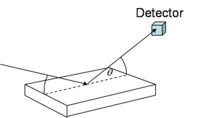X-ray reflectivity

X-ray reflectivity is like using a flashlight to see how shiny a mirror is. Imagine you have a shiny mirror, and you shine a flashlight on it. The light will bounce off the mirror and come back to your eyes. The mirror will look very bright because it is reflecting a lot of light. But if you have a not-so-shiny mirror, the light will bounce off at different angles and not come back to your eyes as much. The mirror will look less bright because it is reflecting less light.
Now let's replace the flashlight with X-rays, which are like really strong and energetic light. Scientists use X-rays to investigate how shiny things are on a very small scale, like a piece of metal or glass. They shine X-rays on the surface of the material and measure how much of the X-rays reflect back. If the material is very smooth, like a mirror, the X-rays will reflect back very strongly, and we can see that the surface is very flat and shiny. But if the material is not so smooth, like a scratched mirror or a piece of paper, the X-rays will reflect back weakly or in different directions, and we can see that the surface is not very flat.
Scientists use this technique to study things like thin films, which are layers of material that are only a few atoms thick. By measuring how X-rays reflect off the surface of the film, they can determine how thick and flat the film is, and even the chemical composition of the different layers. This information is important for understanding how these materials might be used in electronics, coatings, or other applications.
Now let's replace the flashlight with X-rays, which are like really strong and energetic light. Scientists use X-rays to investigate how shiny things are on a very small scale, like a piece of metal or glass. They shine X-rays on the surface of the material and measure how much of the X-rays reflect back. If the material is very smooth, like a mirror, the X-rays will reflect back very strongly, and we can see that the surface is very flat and shiny. But if the material is not so smooth, like a scratched mirror or a piece of paper, the X-rays will reflect back weakly or in different directions, and we can see that the surface is not very flat.
Scientists use this technique to study things like thin films, which are layers of material that are only a few atoms thick. By measuring how X-rays reflect off the surface of the film, they can determine how thick and flat the film is, and even the chemical composition of the different layers. This information is important for understanding how these materials might be used in electronics, coatings, or other applications.
